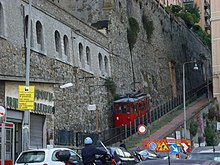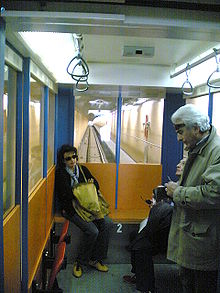AMT (Genoa)
| Azienda Mobilità e Trasporti Genova | |
|---|---|
|
|
|
| Basic information | |
| Company headquarters | Genoa |
| Web presence | www.amt.genova.it |
| Reference year | 2017 |
| owner | 59% city of Genoa , 41% RATP |
| Board | Marco Beltrami (Managing Director) Vittorio Rocchetti (Chairman of the Supervisory Board) |
| Employee | 2,231 |
| Lines | |
| railroad | 1 |
| Subway | 1 |
| bus | 138 |
| Other lines | 1 navebus |
| number of vehicles | |
| Subway car | 23 |
| Omnibuses | 681 |
| other vehicles | 1 navebus |
| statistics | |
| Passengers | 136 million per year |
| Stops | 3.362 |
| Length of line network | |
| Railway lines | 24.3 |
| Subway lines | 7.2 |
| Bus routes | 970 km |
The Azienda Mobilità e Trasporti Genova SpA , or AMT Genova for short , is a transport company for local public transport in the northern Italian port city of Genoa . In addition to the regular bus network , the company also operates the metro Metropolitana di Genova , Ferrovia Genova – Casella , a rack railway , two funicular railways and various elevators in the city. The shares of AMT, registered as a joint stock company, are 59% held by the City of Genoa and 41% by the French RATP .
history
The origins
Towards the end of the 18th century, local public transport had been entrusted to three different companies, but their service was far below their capabilities:
- The Società di Ferrovie Elettriche e Funicolari (FEF, in English: Society for Electric Railways and Funicular Railways ) - a Swiss company that operated an electric tram line between Piazza Manin and Piazza Corvetto , with a length of little more than one kilometer
- The Società Tramways Orientali (TO, in German: Osttramways-Gesellschaft ) - an Italian- Belgian company that only carried out studies on basic projects
- The Compagnia Generale Francese di Tramways (in German: French main company for tramways ), which maintained a horse-drawn tramway in the Ponente and Val Polcevera
The UITE
In 1894 the Allgemeine Elektricitäts-Gesellschaft ( AEG ) from Berlin took over the two companies FEF and TO. One year later, AEG founded two new companies: The Officine Elettriche Genovesi (OEG, in German: Genuesische Elektrizitätswerkstätten ), which, after purchasing the Società Genovese di Elettricità (in German: Genoese Society for Electricity ), have a monopoly over the power supply in local transport should; and the Società Unione Italiana Tramways Elettrici (UITE, in English: Italian Association of Electric Tramways ), which will supply the lines of the Compagnia Generale Francese di Tramways with electricity.
Under the leadership of the new owner, the FEF and the TO implemented a tram network with a total length of more than 53 kilometers in just a few years. In 1901, the FEF and the TO were incorporated into the UITE, making it the only local transport company in a territory that stretched from the districts of Nervi to Voltri and from Prato to Pontedecimo .
During the First World War UITE was taken over by some Italian entrepreneurs, and in 1927 the city of Genoa acquired the majority of the company's shares.
Conversion into a municipal utility
The UITE kept its status as a company until 1965 and was renamed Azienda Municipalizzata Trasporti (AMT, in German: Städtischer Transportbetrieb ) after the city took over the complete management . In this context, profound changes have been made to the local transport network. The tram lines were converted into trolleybus lines , which in turn were converted into regular bus lines by 1973.
With the takeover of various smaller transport companies, which often got into financial difficulties, AMT was able to expand its service to the entire extra-urban area of the Gulf of Genoa.
The first section of the new metro line, the Metropolitana di Genova, was inaugurated on the occasion of the 1990 World Cup . In 1998 a new trolleybus line was opened between the Foce district and the World Trade Center . Due to later road works and changes to the city's road network, however, it was completely closed between 2000 and 2007 and was then partially able to resume operations in the eastern part of Genoa.
privatization
In 1999, AMT was privatized after a public tender and was converted back into a public limited company, the shares of which, however, were held entirely by the city of Genoa.
In 2003, the extra- urban network was transferred to the new company AMT Extra , which was taken over by the Società Tigullio Pubblici Trasporti (in German: Tigullian Society for Public Transport ) after several attempts . This was first renamed Autolinee Liguri Provincia di Genova (ALI, in German: Ligurian Car Lines of the Province of Genoa ) and then merged with the Società Tigullio Pubblici Trasporti to form today's Azienda Trasporti Provinciali SpA (ATP, in German: Provincial Transport Company ).
In 2004 the management of the vehicle fleet and the buildings was transferred to the new company Azienda Mobilità e Infrastrutture (AMI, in English: Mobility and Infrastructure Operation ), which is also under the control of the municipality. A year later, 41% of the shares in AMT were acquired by the French Transdev and the Italian Autoguidovie Italiane (AGI).
In 2007 the trolleybus route was reopened. It now connects the Sampierdarena district with the city center. Due to the reasons mentioned above, however, this line is not yet fully utilized. New trolleybuses are expected in December 2007.
After the merger between Transdev and Veolia , RATP took over 41% of the shares in AMT Genua.
Since April 16, 2010, AMT has also been operating the previously independent Ferrovia Genova-Casella .
offer
AMT operates as of December 31, 2017:
- 138 diesel bus routes and the Volabus
- 1 metro line
- 1 trolleybus line
- 2 funiculars ( Funicolare Sant'Anna and Funicolare Zecca – Righi )
- 1 rack railway ( Principe – Granarolo rack railway )
- 15 elevators
- 3 call buses
- 1 call service for the disabled
- 1 water bus ( Navebus )
In 2017, 136 million passenger trips were recorded on the 1,016 km long route network.
On August 1, 2007, a water bus route was opened. The so-called Navebus connects the Porto Antico with the peripheral Pegli district with eight daily trips (four at the weekend) . The service, which expands the local transport offer in an unusual way, was set up after a long test phase and is still waiting for the public tender for the definitive operator. At the moment the water bus can be used with the regular bus ticket.
The volabus
Among the traditional bus routes there is a shuttle bus service that connects Piazza Principe train station with Cristoforo Colombo airport every hour, seven days a week . The only intermediate stops in Sampierdarena are Via Avio 1 or Via Pacinotti and the Cornigliano train station . The travel time of the so-called Volabus from one terminal to the other is around 20 minutes.
swell
- ↑ Organi di indirizzo politico-amministrativo. AMT, 2018, accessed December 5, 2018 (Italian).
- ↑ Retribuzioni al 31 December 2017. (PDF) AMT, 2018, accessed on December 5, 2018 (Italian, total number of employees in line "TOTALE addetti").
- ↑ a b c AMT in cifre. AMT, December 31, 2017, accessed December 5, 2018 (Italian).
- ^ Ferrovia Genova Casella. AMT, December 31, 2017, accessed December 5, 2018 (Italian).
Web links
- Official Homepage (Italian)




